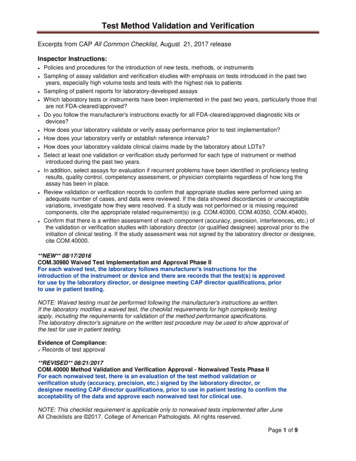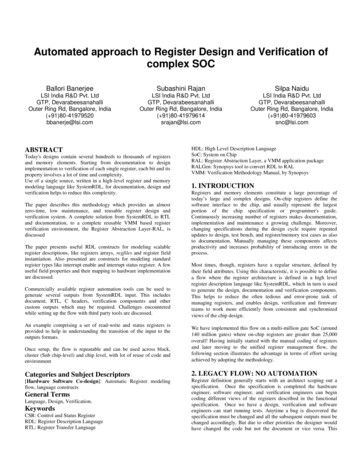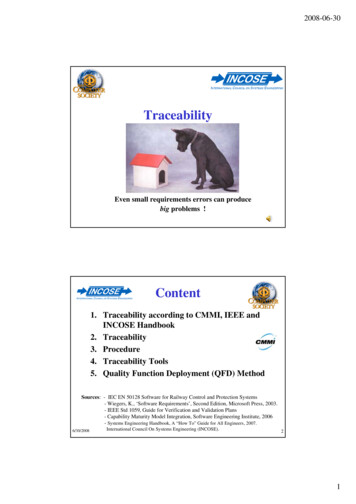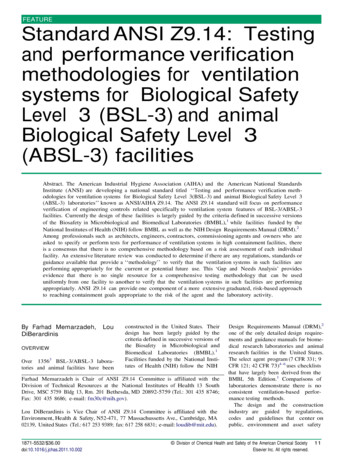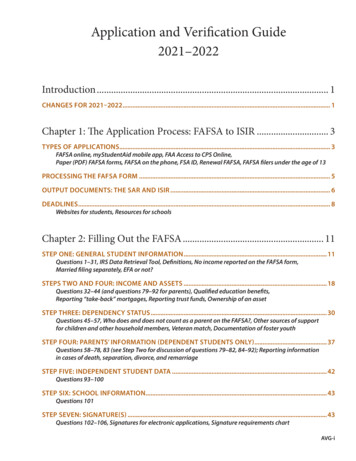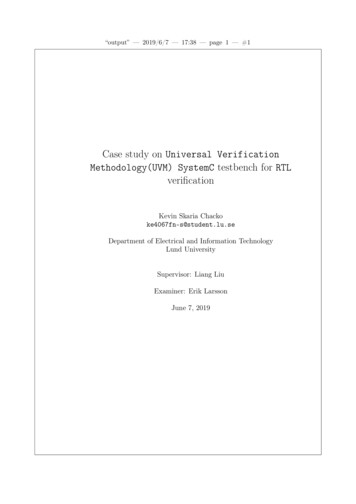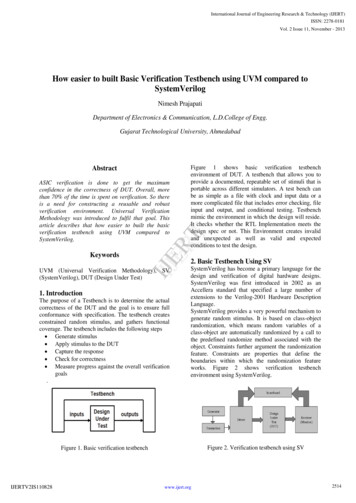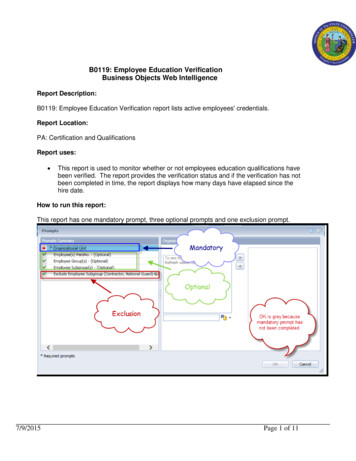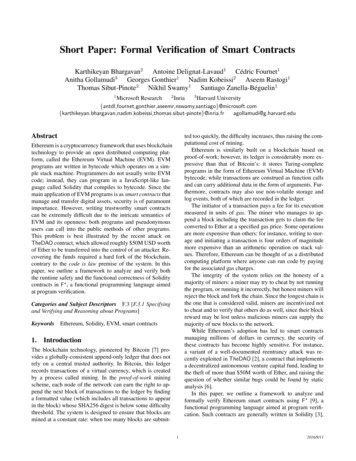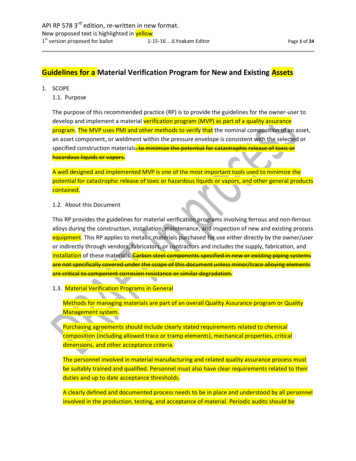
Transcription
MCE Deepwater Development 2016Verification and Validation Challenges ofHP/HT BOP and Well Control EquipmentHarish PatelAmerican Bureau of ShippingPAU, FRANCE 5‐7 APRIL 2016
MCE Deepwater Development 2016Outline Introduction HPHT Well Control Equipment ABS Technology Qualification Process Design Verification Challenges Design Validation Challenges Material Selection Challenges Summary Questions
MCE Deepwater Development 2016Introduction Definition of HPHT HPHT is greater than 15,000 psi and/or greater than 350 F/177 C Code and standards for Well Control Equipment API Std. 53API Spec. 6A, 16A – 4th Edition DraftAPI Std. 16AR – First Edition DraftAPI Spec. 16C – Second EditionAPI Spec. 16D – Third Edition DraftAPI RP 16Q – Second Edition DraftAPI RP 17TR8ASME BPVC Section VIII, Div. 2 and 3 HPHT equipment design process
MCE Deepwater Development 2016HPHT Well Control Equipment Diagram BOP Stack System Wellhead connectorRam BOP/ram blocksC&K connectors, valves, linesHPHT probesLMRP mandrelGas bleed valves Riser System Surface Equipment/Piping Annular Preventer not HPHT
MCE Deepwater Development 2016ABS Technology Qualification (TQ) Per API TR 17TR8 and API TR 1PER15K‐1 Qualification: process of validation and verification of the technology against certainoffshore and marine industry standards and practices Qualification Risk reduction through risk study: HAZID/HAZOP/FMECA Design Verification Validation Testing Verification: to confirm that HPHT equipment design or development activity is incompliance with its functional specifications and there is adequate protectionagainst failure modes identified Validation: to demonstrate that the equipment meets the mechanical integrity andfunctionality/operability requirements as per the functional/design specifications
MCE Deepwater Development 2016Overall TQ Flow Process
MCE Deepwater Development 2016Overall Challenges HPHT conditions exceed capabilities of current drilling equipment 15,000 psi and 250 F are current limitations Lack of codes, standards and/or regulations specific to HPHTsystem/equipment design and manufacturing API 17TR8 Guidelines for production systems API 16A – Annex for HPHT Unknown risk associated with equipment design and operations Regulatory uncertainty and newly proposed regulations Lack of field data and industry experience
MCE Deepwater Development 2016Design Verification Challenges Design standards used and types of analysis chosen Design exceeds or deviates from existing engineering standards FEA verification and calibration with test result Design analysis methods for welding and cladding planned for anyequipment or components Calibration with test results
MCE Deepwater Development 2016Design Verification Challenges Appropriately defined functional design specification/ technicaldesign specification Load cases in the analysis and sequence of applied loads Thermal load analysis and effects Fatigue analysis Verification of sealing components (elastomeric sealing materials)
MCE Deepwater Development 2016Design Validation and Prototype Production
MCE Deepwater Development 2016Design Validation Challenges Test equipment, cost and timeTest equipment calibration prior to test/recalibration after testTesting fluids – stability and suitability at high tempsApplication of strain gauges in test – use of and placementHigh temperature testing – testing to simulate environmental tempsBolting validation test requirementsFailure of associated equipment during testingLoad sequencingDetailed procedures and recording required for testingTesting facilities for prototypes
MCE Deepwater Development 2016Material Selection Challenges TemperatureChemistryManufacturing procedureMaterial propertiesExposure to environment: seawater, wellbore, drilling and completion fluidsGeneral and localized corrosionErosionElastomersDesign lifeCreep at high temperaturesMaterial interactions
MCE Deepwater Development 2016Design Verification and Material Selection Material properties True stressStrain curvesFracture toughness valuesFatigue propertiesDe‐rating factors dueto HT exposure Loading histogram
MCE Deepwater Development 2016Material Design Validation Test conditions during test (temperature, loading conditions, strainrates, etc.) Test coupon sampling Welding procedure concerns Heat treatment sensitivity studies – if new alloys are developed NDE acceptance criteria Probability of detection Agreement on all parties on technique Qualification of manufacturers
MCE Deepwater Development 2016Summary Guidance for HPHT equipment is increasingly necessary in the oil andgas industry Current standards, codes, and regulations provide a high leveloverview for environments above 15,000psi and/or 350 F; however,further detailed descriptions and guidance are in need The Technology Qualification process provides confidence andguidance for the owner, operator, and manufacturer to safely andsystematically utilize their equipment Questions
API Std. 53 API Spec. 6A, 16A –4th Edition Draft API Std. 16AR –First Edition Draft API Spec. 16C –Second Edition API Spec. 16D –Third Edition Draft API RP 16Q –Second Edition Draft API RP 17TR8 ASME BPVC Section VIII, Div. 2 and 3 HPHT equipment design process. MCE Deepwater Development 2016 HPHT Well Control Equipment Diagram BOP Stack System .
